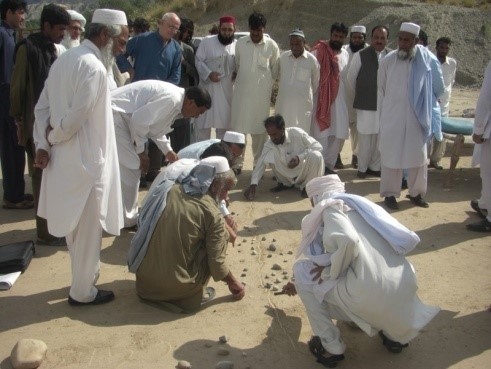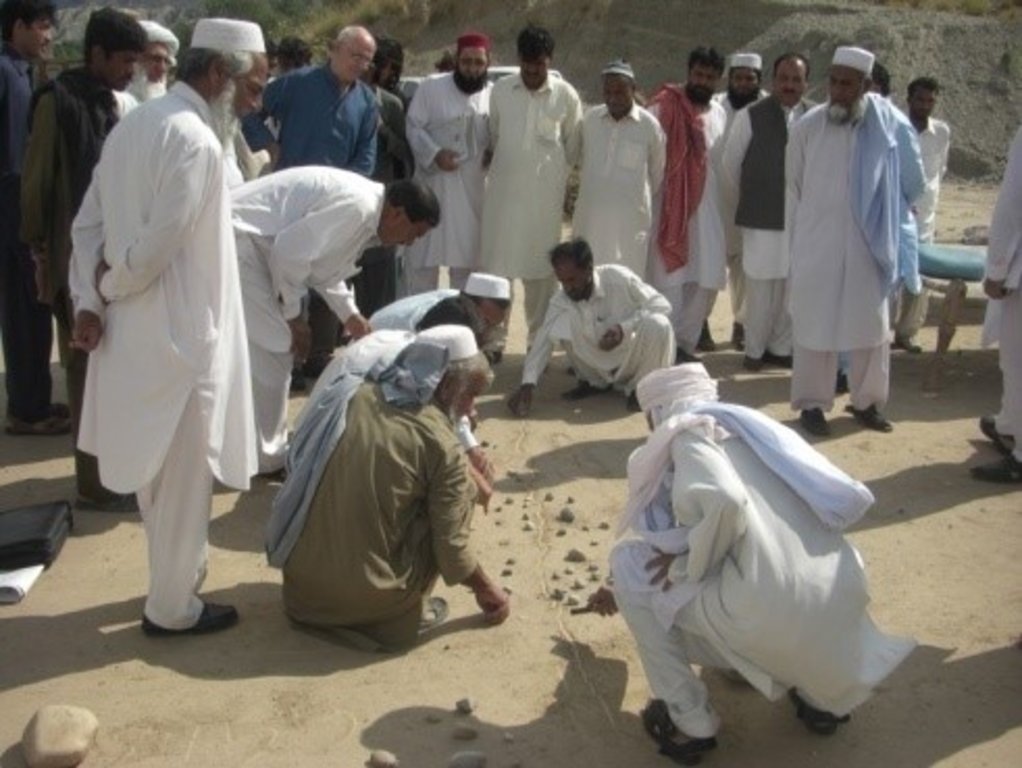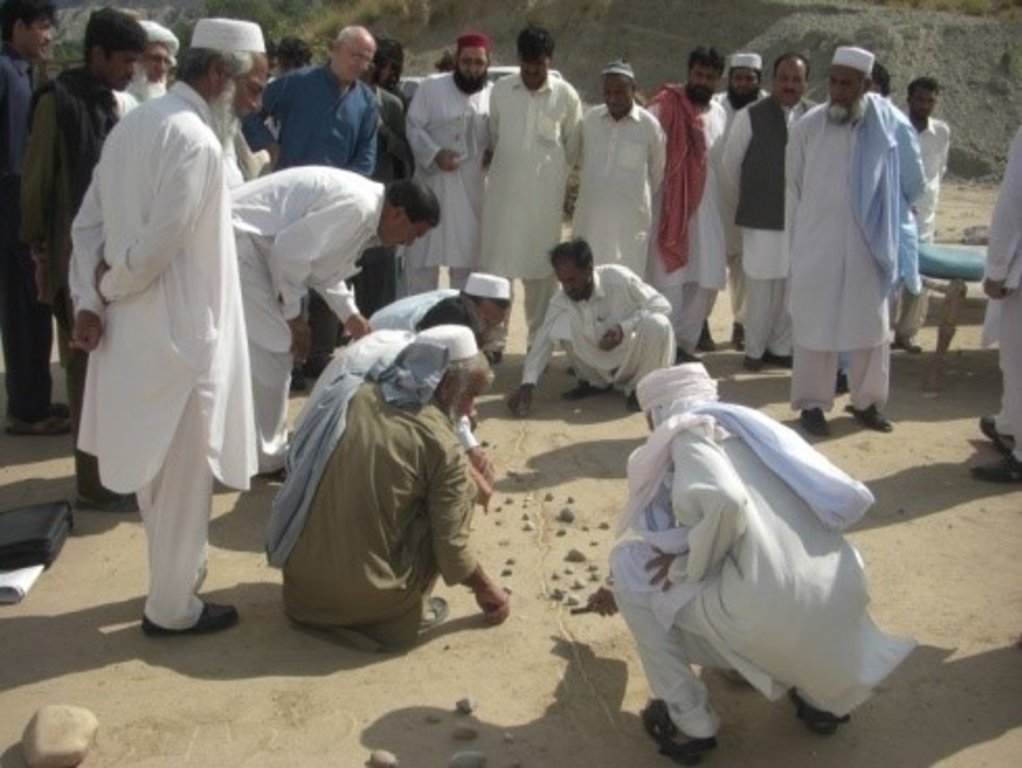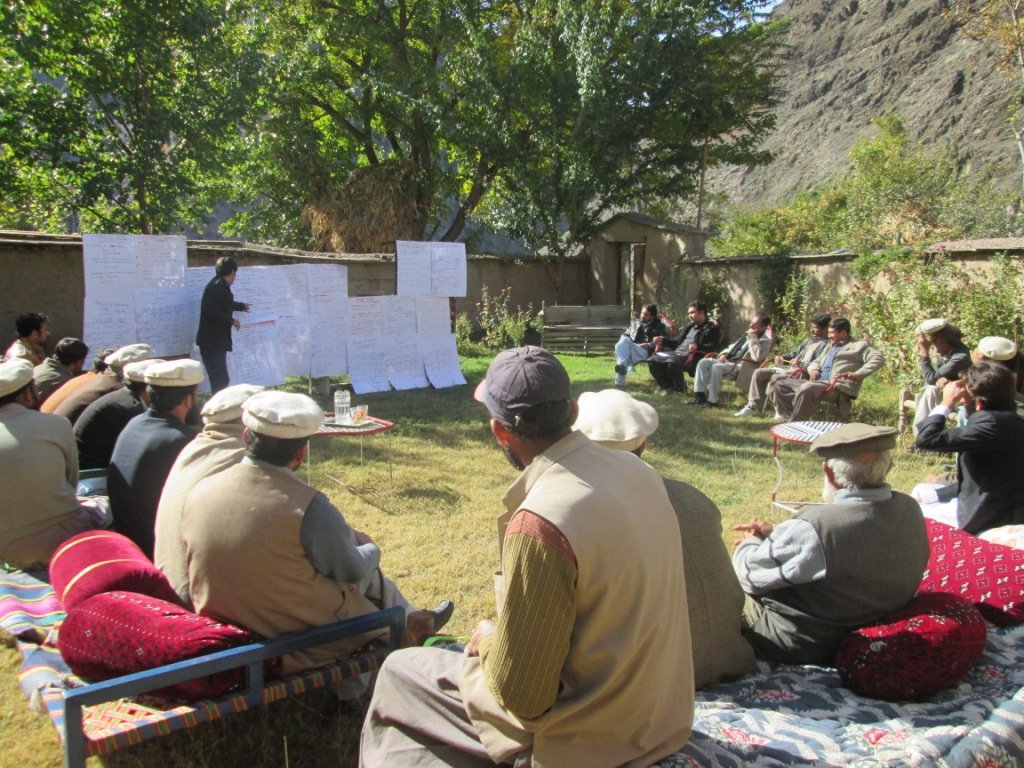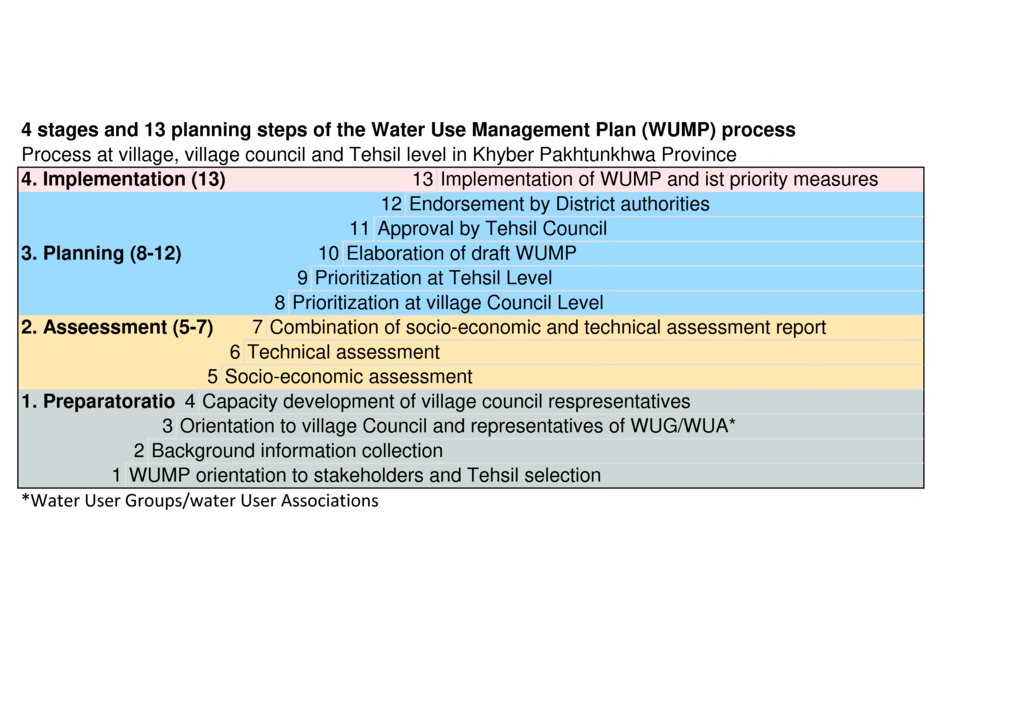Water Use Management Plan (WUMP) [Paquistão]
- Criação:
- Atualização:
- Compilador/a: Eveline Studer
- Editor: Munawar Khan
- Revisores: Alexandra Gavilano, Nicole Harari, Hanspeter Liniger
WUMP
approaches_747 - Paquistão
Veja as seções
Expandir tudo Recolher tudo1. Informação geral
1.2 Detalhes do contato das pessoas capacitadas e instituições envolvidas na avaliação e documentação da abordagem
Nome do projeto que facilitou a documentação/avaliação da Abordagem (se relevante)
Book project: where people and their land are safer - A Compendium of Good Practices in Disaster Risk Reduction (DRR) (where people and their land are safer)Nome da(s) instituição(ões) que facilitou(ram) a documentação/avaliação da Abordagem (se relevante)
HELVETAS (Swiss Intercooperation)1.3 Condições em relação ao uso da informação documentada através de WOCAT
Quando os dados foram compilados (no campo)?
15/11/2014
O compilador e a(s) pessoa(s) capacitada(s) aceitam as condições relativas ao uso de dados documentados através do WOCAT:
Sim
1.4 Referência ao(s) questionário(s) sobre tecnologias da GST
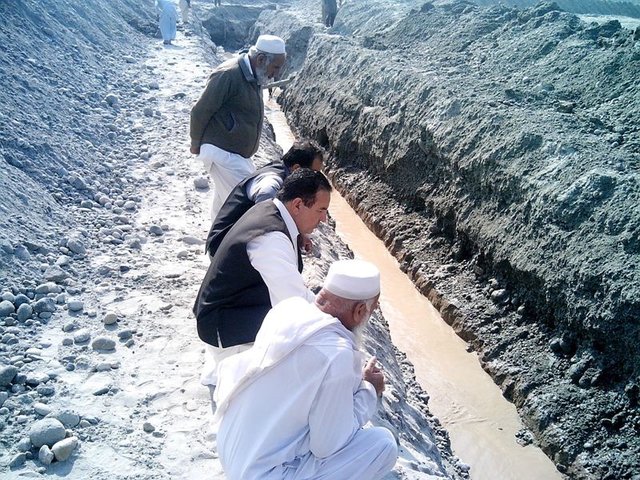
Sub-surface water harvesting for an efficient use of … [Paquistão]
The purpose of this water harvesting technology is to capture, collect and distribute sub-surface water. First, an infiltration gallery is developed, which allows the percolation and collection of sub-surface water through perforated pipes at a depth of approximately 3-4.5 metres. Sub-surface water is filtered by gravel/sand underground and infiltrates into …
- Compilador/a: Eveline Studer
2. Descrição da abordagem de GST
2.1 Descrição curta da abordagem
The overall purpose of WUMP is to compile an inventory of available water ressources in a particular geographical or administrative area, to identify communities' priorities in order to achieve an effective, equitable and efficient use of water resources at local level. This approach promotes a participatory and inclusive analysis and implementation of measures for a sustainable management of water, land and related resources.
2.2 Descrição detalhada da abordagem
Descrição detalhada da abordagem:
The WUMP approach has the following specific objectives:
- to assess water available resource, existing uses and requirements
- to determine water access rights and equity issues through inclusive and interactive dialogues
- to plan and manage water resources - considering multiple needs and uses - in a participatry manner.
- to prioritise required measures, considering climate change and disaster risks
- to promote coordinated water resource development for different stakeholders
- to promote a sustainable use of water, protecting water resources and preservation of the environment
- to strengthen local institutions
- to include economically and socially disadvantaged groups
- to promote an interactive dialogue for improvement of regulatory frameworks and policies in the water sector.
The methode involves field visits by field team to collect information from the community, which is done through focus group discussion, preparation of village maps, social and technical questionnaires
The WUMP process consists of four main stages: 1) Preparation; 2) Assessment/analysis of information ; 3) Planning ; 4) Implementation (see flow chart with according sub-steps).
The process and results of a WUMP:
Is based on a participatory process, which promote inclusiveness. It fosters coordination and collaboration among different local stakeholders including government, communities and private sector and helps to establish the baseline situation and a comun understanding. Land users and other local actors appreciate this approach as it promotes a participatory, transparent process for an equitable distribution of water and a sustainable management of water related resources. The approach helps to overcome potential economic or socio-cultural barriers, by providing a comun space for joint analysis, discussion and solution finding by facilitating interaction between stakeholders of different contexts.
2.3 Fotos da abordagem
2.5 País/região/locais onde a abordagem foi aplicada
País:
Paquistão
Região/Estado/Província:
Dera Ismail Khan Thensil (sub-division), Khyber Pakhtunkhwa (province)
Map
×2.6 Datas de início e término da abordagem
Indique o ano de início:
2014
Ano de término (caso a abordagem não seja mais aplicada):
2019
Comentários:
The approach remains valid and applicable also after the termination of a project intervention.
2.7 Tipo de abordagem
- Baseado em projeto/programa
2.8 Principais metas/objetivos da abordagem
The main aim of the WUMP approach is to assess the availability of water resources, existing uses/demands and future requirements/needs. The WUMP helps to address water access, equity issues and balance these rights through interactive dialogues within the community and other local stakeholders. The WUMP approach contributes therefore actively to water governance and improved management of natural resources.
2.9 Condição que propiciam ou inibem a implementação de tecnologia/tecnologias aplicada(s) segundo a abordagem
Normas e valores sociais/culturais/religiosos
- Propício
The approach helps to overcome potential economic or socio-cultural barriers, by providing a comun space for joint analysis, discussion and solution finding by facilitating interaction between stakeholders of different contexts.
Disponibilidade/acesso a recursos e serviços financeiros
- Propício
The implementation of the WUMP tends to increase access to water for production purposes with a positive impact for households/ communities' income.
The results of the WUMP process with its according priorities of intervention are recognized by local government and reflected in local annual development plans and according budgets.
- the WUMP defines options for other actors to investment in water sector based on communities' priorities.
Quadro institucional
- Propício
WUMP is steered by the district Coordination Committee at district level having representative from all concerned government departments, Water User Association including women members, representatives from civil society where they adress key issues and take decisionsof the local water sector.
Colaboração/coordenção de atores
- Propício
Collaboration among actors is the central element of the WUMP, which pomotes a coordinated water resource development involving different stakeholders: communities and government and non-governmental organizations. The process, enables local institutions to consider needs and participation of economically and socially disadvantaged groups.
Quadro jurídico (posse de terra, direitos de uso da terra e da água)
- Propício
WUMP addresses and defines solutions on water access & equity issues through interactive dialogues.
Políticas
- Propício
WUMP can influence sector policies at local level based on the collections of baseline data and evidence, which contributes to improve frame conditions. Topics, priorities and challenges of the WUMP are addressed with stakeholders at district Coordination Committee, which can actively influence policies of the water sector.
Conhecimento sobre GST, acesso a suporte técnico
- Propício
The local stakeholders, namely communities are directly involved in the implementation of the WUMP, which improves their knowledge about SLM.
3. Participação e papel das partes interessadas envolvidas
3.1 Partes interessadas envolvidas na abordagem e seus papéis
- Usuários de terra/comunidades locais
Rural local communities, water & land users
Participation as an integral part in preparation at village level. Contribution to the assessment, prioritisation and implementation of the interventions
- Organizações comunitárias
Water user associations (WUA)/ water users groups (WUG)
Responsible to support and facilitate the WUMP process, social support, provision of primary information. Ensure participation and involvement of all WUA members. Coordinate with relevant authorities and other development actors to identify technical and financial support in their area / water sector.
- Especialistas em GST/ consultor agrícola
staff of the Water for Livelihoods Project : WUMP coordinator (engineer, male, 53 years), senior engineer (engineer, male, 43 years)
Coaching and guidance at all level, steering of WUMP process in collaboration with District Government, organize trainings as scheduled, support field teams for the collection of technical and social information/data.
- Organização não governamental
Local partner NGO
Project implementation, social mobilisation and interaction at field level to ensure that the social dimension, local concerns deserving support are adressed and that the water user association (WUA) are inclusive and gender concerns are duly represented. Support water user associations in their advocacy efforts to mobilize resources for WUMP.
- Setor privado
Consultant
Compilation of data, collected information and writing of WUMP
- Governo local
District Authorities / Administration
Provision of legal and administrative acceptance, recognition and support to WUMP implementation. Support through provision of timely technical services to water user association /groups in WUMP implementation, validation of information (data regarding drinking water supply, irrigation, water use efficiency, soil conservation by Public Health Engineering Department, Irrigation Department, On Farm Water Management Department, Soil Conservation Department ). Participation to ensure a participatory monitoring and provide feedback to the district govt. for improvements in delivering of water sector services.
- Governo nacional (planejadores, responsáveis pelas decisões)
District and provincial governments
Policy dialogue counter-part to address WUMP issues, which require a change in policies, coordination and engagement with in-line authorities and to allocate resources for the integration and implementation of WUMP in the district development plan (ADP).
- Organização internacional
Swiss Agency for Development and Cooperation (SDC)
Financial ressources. Partner for advocacy and policy dialogues to address key topics in the water sector in their policy dialogue with national government representatives.
Caso várias partes interessadas foram envolvidas, indique a agência líder:
Water for Livelihoods Project
3.2 Envolvimento do usuários de terra/comunidades locais nas diferentes fases da abordagem
| Envolvimento do usuários de terra/comunidades locais | Especifique quem estava envolvido e descreva as atividades | |
|---|---|---|
| Iniciação/motivação | Participativo | Community through water user association (WUA) and water user group (WUG) in their actvities: support and facilitate the WUMP, ensure that all WUGs are involved in the process, link with relevant authorities and other development actors for technical and financial support development. |
| Planejamento | Participativo | Community: WUA/WUG in their activities: Participate as an integral part in the preparation of WUMP at village level. Contribute to conducting feasibility, implementation and execution of interventions. |
| Implementação | Participativo | Community: WUA/WUG in their activities: Support a system for cost contribution by the community. Link with relevant authorities and other development actors for seeking the technical and financial support in their area water sector development. Promote and advocate for sustainable development in the water sector. |
| Monitoramento/avaliação | Participativo | Community: WUA/WUG in their activities: Ensure equitable water rights and promote good water governance principles. Ensure strong linkages with WUA/community through regular meetings and documentation of decisions. |
3.3 Fluxograma (se disponível)
Descrição:
The process of WUMP is divided into 4 stages consisting of 13 steps
Autor:
Syed Hussain Mustafa, Khan Muhammad, Tawheed Gul, Munawar Khan Khattak
3.4 Decisão sobre a seleção de tecnologia/tecnologias de GST
Especifique quem decidiu sobre a seleção de tecnologia/tecnologias a serem implementadas:
- todos os atores relevantes, como parte de uma abordagem participativa
Explique:
The technology is selected via mutual consensuses at village council level. This process is facilitated by a SLM specialist. Women - as well as other vulnerable and marginalized groups - are also part of the water user association and participate in the discussion and decision making process. Where joint setting of men & women is not possible due to cultural constraints, separate meetings of men & women are conducted to cover the voices and concerns of both.
Especifique em que base foram tomadas as decisões:
- Avaliação de conhecimento bem documentado de GST (tomada de decisão baseada em evidências)
- Experiência pessoal e opiniões (não documentado)
4. Suporte técnico, reforço das capacidades e gestão do conhecimento
4.1 Reforço das capacidades/formação
Foi oferecida formação aos usuários da terra/outras partes interessadas?
Sim
Especifique quem foi capacitado:
- Usuários de terra
- Equipe de campo/consultores
- Government department specilist (SLM)
Tipo de formação:
- Em exercício
- Agricultor para agricultor
- Reuniões públicas
Assuntos abordados:
Water resources conservation, efficient use of water resources, irrigation water distribution/ scheduling.
Comentários:
Water Users are trained in different techniques of water conservation, such as water crop budgeting, local flow measuring techniques, irrigation scheduling with regard to specific crops.
The users are specifically trained in techniques for efficient water use, such as furrow irrigation, raised bed irrigation, mulching etc.
4.2 Serviço de consultoria
Os usuários de terra têm acesso a um serviço de consultoria?
Sim
Especifique se foi oferecido serviço de consultoria:
- nas áreas dos usuários da terra
- Em centros permanentes
Descreva/comentários:
SLM specialist made field visits and provided technical guidance to Land Users
The Land Users visited relevant organizations for technical guidance
4.3 Fortalecimento da instituição (desenvolvimento organizacional)
As instituições foram fortalecidas ou estabelecidas através da abordagem?
- Sim, moderadamente
Especifique a que nível (níveis) as instituições foram fortalecidas ou estabelecidas:
- Local
Descreva instituição, papéis e responsabilidades, membros, etc.
Water User Association (WUA, local Institutions) at district & sub-district level were strengthened. The legally recognize WUA and Apex of the WUA take gradually responsibilities to support and facilitate the WUMP process. The WUAs strives for improvements in the water sector and are a catalyst to bring together and pool communities, civil society organisations, local authorities and other actors of different actors for to address water issues and development options.
Especifique o tipo de apoio:
- Reforço das capacidades/formação
Dê mais detalhes:
Project provided trainings for 16 Water User Associations (WUAs) and 3 Apex WUAs in Chitral, Karak, and DI Khan. These 16 associations aim to improve development in the water sector, to improve water governance to contribute to resolutions in case of disputes amongst different water right holders for an equitable access to water at local and at district level.
Through these trainings, the WUGs/ WUAs members representing various groups/ associations - including representatives from Government Line Agencies are trained in community management & skill training, mediation in case of water disputes, monitoring/documentation and health/hygiene.
4.4 Monitoramento e avaliação
Monitoramento e avaliação são partes da abordagem?
Sim
Comentários:
The principle of the monitoring, is to actively engage the communities associations (WUA/WUG) and capture their observations and concerns.
This is done through direct feedbacks from communities, during regular field visits and interaction with technical departments, who receive feedbacks from communities based on regular exchanges.
Caso afirmativo, esta documentação é destinada a ser utilizada para monitoramento e avaliação?
Não
Comentários:
This documentation is not primarily used for monitoring & evaluation purpose. However it contributes to establish a baseline.
4.5 Pesquisa
A pesquisa foi parte da abordagem?
Não
5. Financiamento e apoio material externo
5.1 Orçamento anual para o componente de GST da abordagem
Caso o orçamento exato seja desconhecido, indique a faixa:
- 2.000-10.000
Comentários (p. ex. principais fontes de recursos/principais doadores):
The cost for the preparation of WUMP depends on the size of the area
5.2 Apoio financeiro/material concedido aos usuários da terra
Os usuários da terra receberam apoio financeiro/material para a implementação de tecnologia/tecnologias?
Sim
Caso afirmativo, especifique tipo(s) de apoio, condições e fornecedor(es):
The project and governamental counter parts (Department) provide material and technical support. The community provides in-kind contribution through labor and local material for the imlementation of the measures/ technology.
5.3 Subsídios para entradas específicas (incluindo mão-de-obra)
Se a mão-de-obra pelos usuários da terra foi uma entrada substancial, isso foi:
- Voluntário
5.4 Crédito
Foi concedido crédito segundo a abordagem para atividades de GST?
Não
5.5 Outros incentivos ou instrumentos
Foram utilizados outros incentivos ou instrumentos para promover a implementação das tecnologias de GST?
Não
6. Análise de impactos e declarações finais
6.1 Impactos da abordagem
A abordagem concedeu autonomia aos usuários locais de terra, melhorou a participação das partes interessadas?
- Não
- Sim, pouco
- Sim, moderadamente
- Sim, significativamente
The approach supports land and water users to make decisions regarding water use by their own.
A abordagem propiciou a tomada de decisão baseada em evidências?
- Não
- Sim, pouco
- Sim, moderadamente
- Sim, significativamente
The preparation stage includes an analysis, where information for evidence and later decisions is collected. Once the effectiveness of the approach is recognized, it can be replicated by other communities them-selfs.
A abordagem auxiliou os usuários da terra a implementar e manter as tecnologias de GST?
- Não
- Sim, pouco
- Sim, moderadamente
- Sim, significativamente
Land users are involved for the implementation and maintenance of the prioritized measures in the WUMP plan, which an efficient use water for productiion and drinking purposes.
A abordagem melhorou a coordenação e a implementação economicamente eficiente da GST?
- Não
- Sim, pouco
- Sim, moderadamente
- Sim, significativamente
The WUMP provides options for cost sharing mechanisms amongst different actors, to attract funding for prioritized initiatives. The prioritized initiatives of WUMP are jointly implemented by different stakeholders, which can reduce its costs.
A abordagem mobilizou/melhorou o acesso aos recursos financeiros para implementação da GST?
- Não
- Sim, pouco
- Sim, moderadamente
- Sim, significativamente
The results of WUMP (measures) are included in the official departmental annual development plans and budgets.
A abordagem aprimorou o conhecimento e as capacidades dos usuários da terra para implementar a GST?
- Não
- Sim, pouco
- Sim, moderadamente
- Sim, significativamente
The land and water users learnt how to analyse and assess water resources. They learnt about options to address the identified challenges.
A abordagem aprimorou o conhecimento e as capacidades de outras partes interessadas?
- Não
- Sim, pouco
- Sim, moderadamente
- Sim, significativamente
Similarly, all other involved stakeholders' learn how to analysse and asses water resources and know about options to address them.
A abordagem construiu/fortaleceu instituições, colaboração entre partes interessadas?
- Não
- Sim, pouco
- Sim, moderadamente
- Sim, significativamente
By establishing a district coordination committee to steer the approach (WUMP) all stakeholders can jointly discuss, address their needs and suggest options to be prioritized.
A abordagem atenuou conflitos?
- Não
- Sim, pouco
- Sim, moderadamente
- Sim, significativamente
Through this approach all stakeholders - especially the up-stream & down stream users - can resolve their water related disputes through dialogue. This contributes to resolve disputes between communities and concerned department.
A abordagem concedeu autonomia aos grupos social e economicamente desfavorecidos?
- Não
- Sim, pouco
- Sim, moderadamente
- Sim, significativamente
Disadvantaged groups participate in the preparation process of the plan, where they reflect and contribute with their concerns, needs and priorities.
A abordagem melhorou a igualdade de gêneros e concedeu autonomia a mulheres e meninas?
- Não
- Sim, pouco
- Sim, moderadamente
- Sim, significativamente
Same participation as the disadvantaged groups. Women are also part of the decision making body.
A abordagem encorajou os jovens/as próximas gerações de usuários de terra a se envolverem na GST?
- Não
- Sim, pouco
- Sim, moderadamente
- Sim, significativamente
Same participation as the disadvantaged groups. Generall people of the age group 30-45 have are the leader of associations - supported by their elders - to address and develop water ressouce management of their villages.
A abordagem resultou em segurança alimentar aprimorada/nutrição melhorada?
- Não
- Sim, pouco
- Sim, moderadamente
- Sim, significativamente
Through the approach water efficient technologies are promoted, which allow to increase production and improve food security.
A abordagem resultou em acesso melhorado à água e ao saneamento?
- Não
- Sim, pouco
- Sim, moderadamente
- Sim, significativamente
Through the approach options to improve access to water for domestic use are promoted. Access to clean drinking water at households' proximity contributes to improved sanitation.
A abordagem aprimorou a capacidade dos usuários da terra de adaptar-se a mudanças climáticas/extremos e atenuar os desastres relacionados com o clima?
- Não
- Sim, pouco
- Sim, moderadamente
- Sim, significativamente
The result of the WUMP approach is a set of options, where efficient use of water and water saving technologies are promoted e.g. water harvesting.
6.2 Principal motivação dos usuários da terra para implementar a GST
- Produção aumentada
WUMP aims to improve access and availability of water. More water for irrgation and efficient water use technologies contribute to increased yields. Consequently surface for agricultural production can be extended.
- Lucro (lucrabilidade) aumentado, melhora da relação custo-benefício
By promoting efficient water utilization techniques, this can reduce costs, especially where power driven water pumping is involved.
- Degradação do solo reduzida
Earlier in areas of water scarcity flood irrigation, which leds to erosion, was applied. This approach helps to promote more sustainble irrigation options.
- Riscos de desastre reduzido
In the initial analysis stage of WUMP different water related hazards, mainly floods and droughts, are identified. As a result options to reduce according risks are identified and promoted.
- normas e regulamentos (multas)/aplicação
This approach help in aligning the traditional rules with formal rules and regulation in water management. The associations are not only right holders but they are also duty barer to communities.
- Consciência ambiental
The approach promotes a sustainable water resource management. It promotes conservation and balances it with an efficient use of water fo rdifferent purposes. At the assessment stage potential problems related to unsustainable practices are analized and addressed.
- melhoria dos conhecimentos e aptidões de GST
Communities are informed and empowered to identify and contribute to the implementation of options for sustainable water management.
- Atenuação de conflitos
This approach provide opportunity to all stakeholders especially the up-stream & down stream users to resolve water related disputes through a joint dialogue. It further contributes to resolve disputes between communities and govtl. departments.
6.3 Atividades de sustentabilidade de abordagem
Os usuários da terra podem manter o que foi implementado através da abordagem (sem apoio externo)?
- Sim
Caso afirmativo, descreva como:
For the prioritisation of technologies implemented through WUMP, options which require only minimal external inputs and are easy to sustain by the land user, where promoted.
6.4 Pontos fortes/vantagens da abordagem
| Pontos fortes/vantagens/oportunidades na visão do usuário da terra |
|---|
|
Participatory and inclusive process, which ensures ownership by local actors, promotes coordination and fosters partnerships between different actors. |
| The proritized measures selected through the WUMP approach promote a sustainable use of water resources through water conservation and efficient water use. |
| Pontos fortes/vantagens/oportunidades na visão do compilador ou de outra pessoa capacitada |
|---|
|
Strengthening of local institutional capacities, establishment ofan inventory/ data used as base line in the water sector. |
|
Flexible for improvement, since the WUMP is reviewed each 3-5 year |
| Officially recognized and accepted planning tool at regional level, which provides opportunities for investment by other actors based on communities' priorities. |
6.5 Pontos fracos, desvantagens da tecnologia e formas de superá-los
| Pontos fracos/desvantagens/riscos na visão do usuário da terra | Como eles podem ser superados? |
|---|---|
|
Time consuming preparation process, high initial cost for the preparation |
Ensure regular feature of planing (continuous process) |
| Lack of technical capacities at local level | Capacity building trainings of local institutions (VOs/ WUAs/WUGs) in planning. Provide suport at local level through the project and government extension services. |
| Pontos fracos/vantagens/riscos na visão do compilador ou de outra pessoa capacitada | Como eles podem ser superados? |
|---|---|
|
Replication and upscaling require talor-made adjustments |
Technical capacity building of govt. departments. |
| WUMP application in large scale in areas (big catchment areas, limited access) | Lobbying for support and resources at different governmental level. |
| Important mobilisation of resources by other stakeholders for implementation | Inclusion of WUMP priorities by the govt. department in their respective annual development plans. |
7. Referências e links
7.1 Métodos/fontes de informação
- visitas de campo, pesquisas de campo
- field visit all involved villages, organisation of focal group discussions
- entrevistas com usuários de terras
land user where the key informants.
- entrevistas com especialistas em GST
Meeting with technical departments for data/ information regarding their respective services and experience
- compilação de relatórios e outra documentação existente
Support from secondary data/ reports of the concerned department, analysis of the primary data, compilation and reporting.
7.3 Links para informação relevante que está disponível online
Título/ descrição:
Water Use master Plan (WUMP) Project experience Nepal, Helvetas Swiss Intercooperation Nepal
URL:
https://assets.helvetas.org/downloads/13_waterusemasterplan_wump_blau_final_engl_a4_portrait.pdf
Título/ descrição:
Water Use master Plan (WUMP) - facilitator's guide book, 2015, Helvetas Swiss Intercooperation Nepal
URL:
http://www.rainfoundation.org/wp-content/uploads/2016/04/Nepal-Module-final_SF.pdf
Links e módulos
Expandir tudo Recolher tudoLinks

Sub-surface water harvesting for an efficient use of … [Paquistão]
The purpose of this water harvesting technology is to capture, collect and distribute sub-surface water. First, an infiltration gallery is developed, which allows the percolation and collection of sub-surface water through perforated pipes at a depth of approximately 3-4.5 metres. Sub-surface water is filtered by gravel/sand underground and infiltrates into …
- Compilador/a: Eveline Studer
Módulos
Não há módulos


